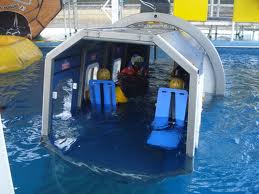Ergonomics and Offshore Oil Platforms – HUET Training
11/19/2012

by Blake McGowan, CPE
 There are many things that are new and exciting when one works at Humantech. There is the standard list; working as part of a team of dedicated professionals, working in foreign countries, being introduced to diverse cultures, a great variety of types of business, and so on. But one thing I had never anticipated was being submersed upside down in a tank of water. Allow me to explain.
There are many things that are new and exciting when one works at Humantech. There is the standard list; working as part of a team of dedicated professionals, working in foreign countries, being introduced to diverse cultures, a great variety of types of business, and so on. But one thing I had never anticipated was being submersed upside down in a tank of water. Allow me to explain.
As in many industries, ergonomic hazards, such as awkward postures and high forces, are present in the oil and gas industry. Ergonomic hazards may include:
- Exerting high force when operating valves or servicing wells in areas like the Hugoton Gas Fields in Kansas
- Limited accessibility to valves and equipment in a California oil refinery
- Extremely high forces while setting up the rig when drilling for shale gas in the Arkoma Basin
- Improper working heights due to poor scaffolding during a turnaround in a Louisiana oil refinery
The offshore oil platform can be particularly challenging when it comes to ergonomics. This environment has its own additional hazards:
- Manual material handling (lifting, lowering, pushing, pulling, or carrying) during deck operations and drilling activities in Alaska
- Tight spaces with limited hand, arm, tool, and visual access, when performing maintenance tasks in the Gulf of Mexico
Access to both onshore and offshore oil and gas facilities requires the completion of several training activities. It is the norm to receive detailed safety training in topics such as personal protective equipment (PPE), known hazards (physical and chemical), and emergency response, before entering any onshore refinery, gas field, or plant. And security credentials, such as the Transportation Worker Identification Credentials (TWIC), are required for access to many facilities. When going offshore, additional training is required to ensure personal safety and health, like the Medical Certificate of Fitness for Offshore Work. My personal favorite is Helicopter Underwater Egress Training (HUET), which includes being able to safely escape a submerged helicopter, as well as survive in the open water. Here’s what you need to be able to do to obtain your HUET certificate:
- While wearing fire resistant clothing and full PPE, strap yourself to the seat inside the helicopter cab and prepare to be submerged in water (without any breathing apparatus), and hold your breath.
- With your eyes closed (to simulate the dark ocean environment), locate the window and the small tab for the window seal, and then grasp and pull the tab.
- Locate the window pane and find the corner of the window that is closest to your shoulder.
- Apply force to the corner of the window so that it pops out (this may take several tries), and then push the window pane from the frame.
- Unbuckle your seat harness or waist belt (did I mention that while submerged, the helicopter will rotate 180° so that you are upside down?), and then escape through the window and swim up to the surface.
- Breathe, and then apply several learned skills to float or stay above water.
My HUET experience was certainly exhilarating and added to my personal Bucket list of unique experiences, but most importantly, the training provided me with the skills to survive such an event should it ever come to pass.






